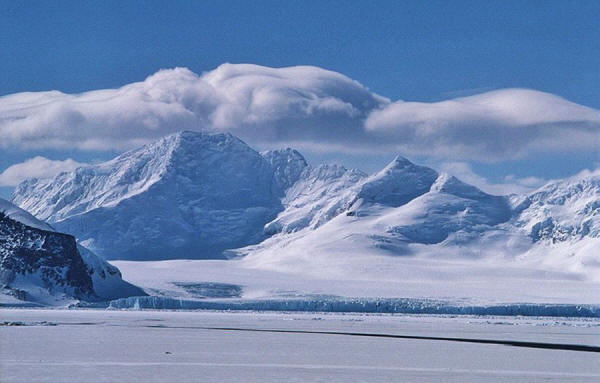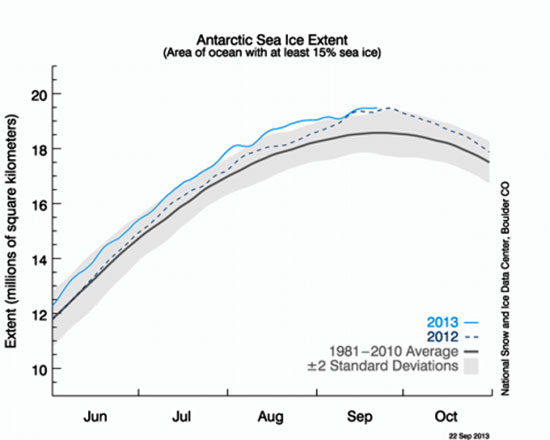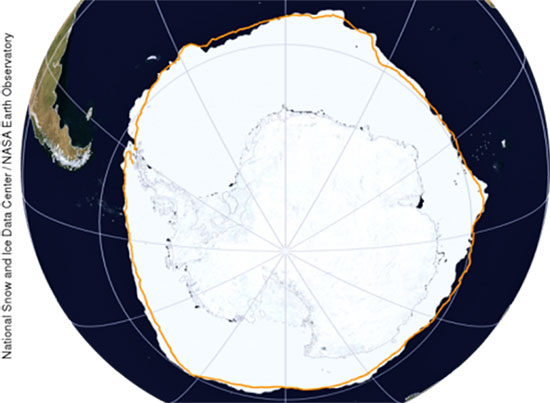|

by Jason Samenow
September
23, 2013
from
WashingtonPost Website
|
Jason
is the Washington Post’s weather editor and Capital
Weather Gang's chief meteorologist. He earned a master's
degree in atmospheric science, and spent 10 years as a
climate change science analyst for the U.S. government.
He holds the Digital Seal of Approval from the National
Weather Association.
Follow @capitalweather. |

Scientists cannot explain why the ice is getting
thicker, stronger and colder, but they are sure that
'global warming' will soon overcome the trend.
This
underscores the 'religious nature' of the Technocrat
mind.
Source
Antarctic sea ice has grown to a record large extent for a second
straight year, baffling scientists seeking to understand why this
ice is expanding rather than shrinking in a warming world.
On Saturday, the
ice extent reached 19.51 million square kilometers, according to
data posted on the
National Snow and Ice Data Center Web site.
That number bested
record high levels set earlier this month and in 2012 (of 19.48
million square kilometers).
Records date back
to October 1978.

(NSIDC)
The increasing ice
is especially perplexing since the water beneath the ice has warmed,
not cooled.
"The
overwhelming evidence is that the Southern Ocean is warming,"
said
Jinlun Zhang, a University of Washington scientist, studying
Antarctic ice.
"Why would sea
ice be increasing? Although the rate of increase is small, it is
a puzzle to scientists."
In
a new study
(Modeling
the Impact of Wind Intensification on Antarctic Sea Ice Volume) in the Journal of Climate, Jinlun Zhang finds
both strengthening and converging winds around the South Pole can
explain 80 percent of the increase in ice volume which has been
observed.
"The polar
vortex that swirls around the South Pole is not just stronger
than it was when satellite records began in the 1970s, it has
more convergence, meaning it shoves the sea ice together to
cause ridging," the
study's press release explains.
"Stronger winds
also drive ice faster, which leads to still more deformation and
ridging.
This creates
thicker, longer-lasting ice, while exposing surrounding water
and thin ice to the blistering cold winds that cause more ice
growth."

Antarctic sea ice extent
on September 22 compared to 1981-2010
median depicted by orange curve
(NSIDC)
But no one seems to
have a conclusive answer as to why winds are behaving this way.
"I haven't seen
a clear explanation yet of why the winds have gotten stronger,"
Zhang
told Michael Lemonick of Climate Central.
Some
point to stratospheric
ozone depletion, but a
new study
(Delayed
Southern Hemisphere Climate Change Induced by Stratospheric Ozone
Recovery, as Projected by the CMIP5 Models) published in the Journal of Climate notes that
computer models simulate declining - not increasing - Antarctic sea
ice in recent decades due to this phenomenon (aka the ozone "hole").
"This modeled
Antarctic sea ice decrease in the last three decades is at odds
with observations, which show a small yet statistically
significant increase in sea ice extent,"
says the study, led by Colorado State University atmospheric
scientist Elizabeth Barnes.
A
recent study
(Can
Natural Variability Explain Observed Antarctic Sea Ice Trends? - New
Modeling Evidence from CMIP5) by Lorenzo Polvani and Karen Smith of
Columbia University says the model-defying sea ice increase may just
reflect natural variability.
If the increase in
ice is due to natural variability, Zhang says, warming from manmade
greenhouse gases should eventually overcome it and cause the ice to
begin retreating.
"If the warming
continues, at some point the trend will reverse," Zhang said.
However, a
conclusion of the Elizabeth Barnes study is that the recovery
of the stratospheric
ozone layer - now underway - may slow/delay
Antarctic warming and ice melt.
Ultimately, it's
apparent the relationship between,
...is all very complicated.
In sharp contrast,
in the Arctic, there seems to be a relatively straight forward
relationship between temperature and ice extent.
Thus, in the
Antarctic, we shouldn't necessarily expect to witness the kind of
steep decline in ice that has occurred in the Arctic.
"…the seeming
paradox of Antarctic ice increasing while Arctic ice is
decreasing is really no paradox at all," explains Climate
Central's Lemonick.
"The Arctic is
an ocean surrounded by land, while the Antarctic is land
surrounded by ocean. In the Arctic, moreover, you've got sea ice
decreasing in the summer; at the opposite pole, you've got sea
ice increasing in the winter.
It's not just
an apples-and-oranges comparison: it's more like comparing apple
pie with orange juice."
|




